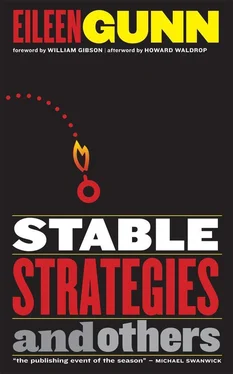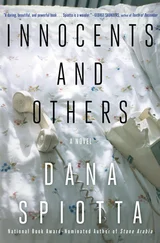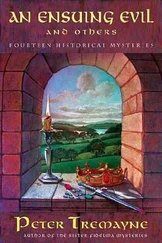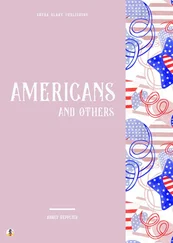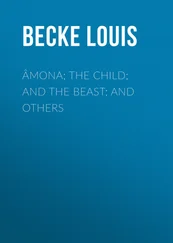The monitors called everyone to attention and told them to put on their headsets and ask their boxes for Section One.
Elizabeth followed directions, and she found that all the interfaces were strange — they were friendly enough, but none of them were the programs she worked with at home. The first part of the test was the multiple-choice exam. The problems, at least, were familiar to Elizabeth — she’d practiced for this test all her life, it seemed. There were word games, number games, and games in which she had to rotate little boxes in her head. She knew enough to skip the hardest until she’d worked her way through the whole test. There were only a couple of problems left to do when the system told her to stop and the box went all grey.
The monitors led the whole room full of kids in jumping-jack exercises for five minutes. Then everyone sat down again and a new test came up in the box. This one seemed very easy, but it wasn’t one she’d ever done before. It consisted of a series of very detailed pictures; she was supposed to make up a story about each picture. Well, she could do that. The first picture showed a child and a lot of different kinds of animals. “Once upon a time there was a little girl who lived all alone in the forest with her friends the skunk, the wolf, the bear, and the lion….” A beep sounded every so often to tell her to end one story and begin another. Elizabeth really enjoyed telling the stories, and was sorry when that part of the test was over.
But the next exercise was almost as interesting. She was to read a series of short stories and answer questions about them. Not the usual questions about what happened in the story — these were harder. “Is it fair to punish a starving cat for stealing?” “Should people do good deeds for strangers?” “Why is it important for everyone to learn to obey?”
When this part was over, the monitors took the class down the hall to the big cafeteria, where there were lots of other seven-year-olds, who had been taking tests in other rooms.
Elizabeth was amazed at the number and variety of children in the cafeteria. She watched them as she stood in line for her milk and sandwich. Hundreds of kids, all exactly as old as she was. Tall and skinny, little and fat; curly hair, straight hair, and hair that was frizzy or held up with ribbons or cut into strange patterns against the scalp; skin that was light brown like Elizabeth’s, chocolate brown, almost black, pale pink, freckled, and all the colors in between. Some of the kids were all dressed up in fancy clothes; others were wearing patched pants and old shirts.
When she got her snack, Elizabeth’s first thought was to find someone who looked like herself, and sit next to her. But then a freckled boy with dark, nappy hair smiled at her in a very friendly way. He looked at her feet and nodded. “Nice shoes,” he said. She sat down on the empty seat next to him, suddenly aware of her red maryjanes with the embroidered flowers. She was pleased that they had been noticed, and a little embarrassed.
“Let me see your shoes,” she said, unwrapping her sandwich.
He stuck his feet out. He was wearing pink plastic sneakers with hologram pictures of a missile gantry on the toes. When he moved his feet, they launched a defensive counterattack.
“Oh, neat.” Elizabeth nodded appreciatively and took a bite of the sandwich. It was filled with something yellow that tasted okay.
A little tiny girl with long, straight, black hair was sitting on the other side of the table from them. She put one foot up on the table. “I got shoes, too,” she said. “Look.” Her shoes were black patent, with straps. Elizabeth and the freckled boy both admired them politely. Elizabeth thought that the little girl was very daring to put her shoe right up on the table. It was certainly an interesting way to enter a conversation.
“My name is Sheena and I can spit,” said the little girl. “Watch.” Sure enough, she could spit really well. The spit hit the beige wall several meters away, just under the mirror, and slid slowly down.
“I can spit, too,” said the freckled boy. He demonstrated, hitting the wall a little lower than Sheena had.
“I can learn to spit,” said Elizabeth.
“All right there, no spitting!” said a monitor firmly. “Now, you take a napkin and clean that up.” It pointed to Elizabeth.
“She didn’t do it, I did,” said Sheena. “I’ll clean it up.”
“I’ll help,” said Elizabeth. She didn’t want to claim credit for Sheena’s spitting ability, but she liked being mistaken for a really good spitter.
The monitor watched as they wiped the wall, then took their thumbprints. “You three settle down now. I don’t want any more spitting.” It moved away. All three of them were quiet for a few minutes, and munched on their sandwiches.
“What’s your name?” said Sheena suddenly. “My name is Sheena.”
“Elizabeth.”
“Lizardbreath. That’s a funny name,” said Sheena.
“My name is Oginga,” said the freckled boy.
“That’s really a funny name,” said Sheena.
“You think everybody’s name is funny,” said Oginga. “Sheena-Teena-Peena.”
“I can tap dance, too,” said Sheena, who had recognized that it was time to change the subject. “These are my tap shoes.” She squirmed around to wave her feet in the air briefly, then swung them back under the table.
She moves more than anyone I’ve ever seen, thought Elizabeth.
“Wanna see me shuffle off to Buffalo?” asked Sheena.
A bell rang at the front of the room, and the three of them looked up. A monitor was speaking.
“Quiet! Everybody quiet, now! Finish up your lunch quickly, those of you who are still eating, and put your wrappers in the wastebaskets against the wall. Then line up on the west side of the room. The west side….”
The children were taken to the restroom after lunch. It was grander than any bathroom Elizabeth had ever seen, with walls made of polished red granite, lots of little stalls with toilets in them, and a whole row of sinks. The sinks were lower than the sink at home, and so were the toilets. Even the mirrors were just the right height for kids.
It was funny because there were no stoppers in the sinks, so you couldn’t wash your hands in a proper sink of water. Sheena said she could make the sink fill up, and Oginga dared her to do it, so she took off her sweater and put it in the sink, and sure enough, it filled up with water and started to overflow, and then she couldn’t get the sweater out of it, so she called a monitor over. “This sink is overflowing,” she said, as if it were all the sink’s fault. A group of children stood around and watched while the monitor fished the sweater from the drain and wrung it out.
“That’s mine!” said Sheena, as if she had dropped it by mistake. She grabbed it away from the monitor, shook it, and nodded knowingly to Elizabeth. “It dries real fast.” The monitor wanted thumbprints from Sheena and Elizabeth and everyone who watched.
The monitors then took the children to the auditorium, and led the whole group in singing songs and playing games, which Elizabeth found only moderately interesting. She would have preferred to learn to spit. At one o’clock, a monitor announced it was time to go back to the classrooms, and all the children should line up by the door.
Elizabeth and Sheena and Oginga pushed into the same line together. There were so many kids that there was a long wait while they all lined up and the monitors moved up and down the lines to make them straight.
“Are you going to go to the Asia Center?” asked Sheena. “My mom says I can probably go to the Asia Center tomorrow, because I’m so fidgety.”
Elizabeth didn’t know what the Asia Center was, but she didn’t want to look stupid. “I don’t know. I’ll have to ask my dad.” She turned to Oginga, who was behind her. “Are you going to the Asia Center?”
Читать дальше
